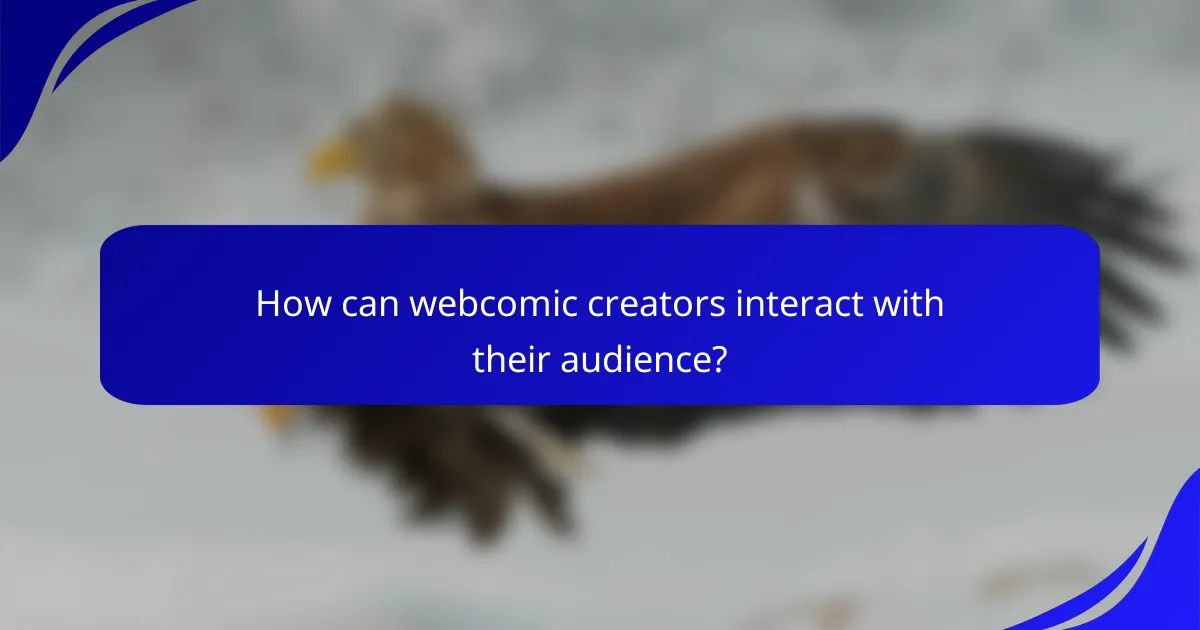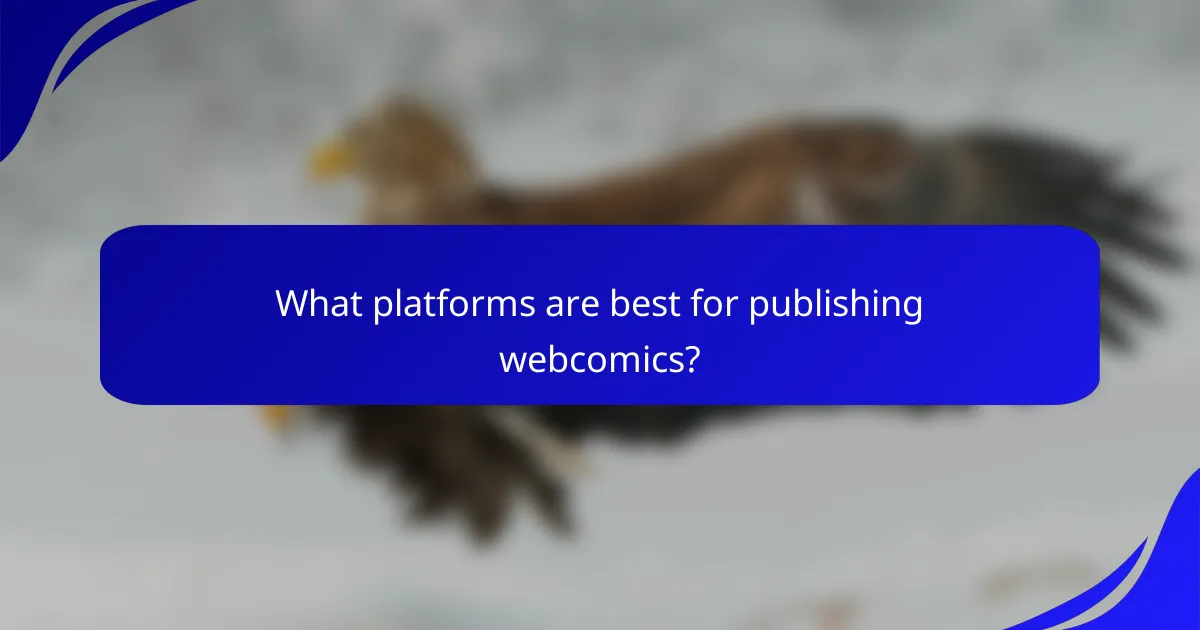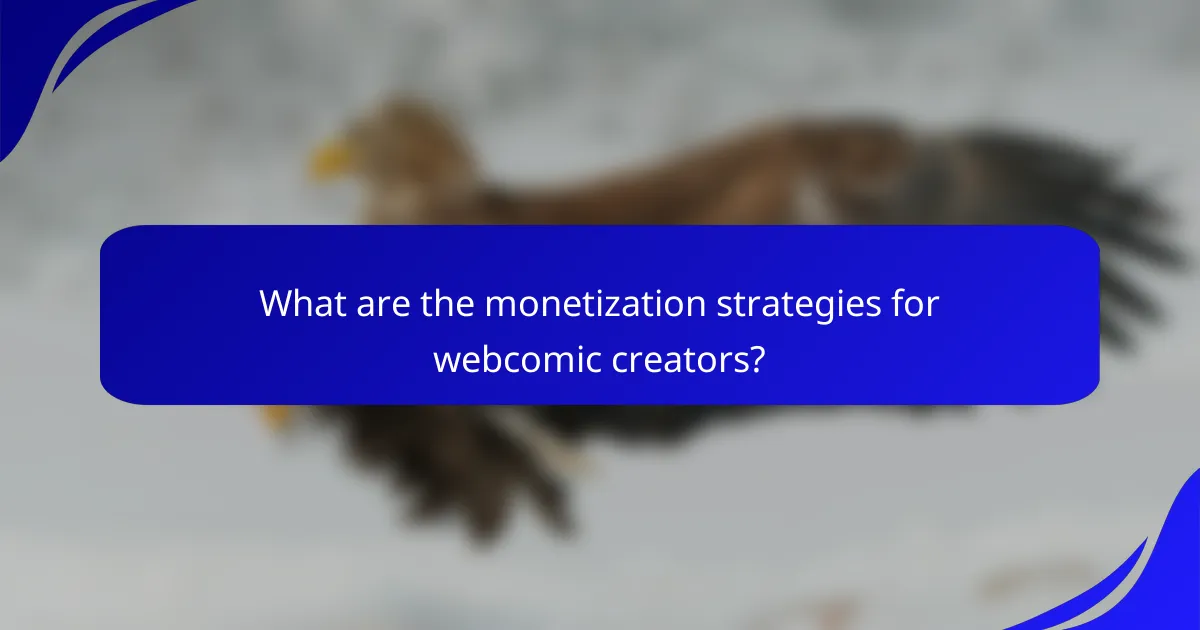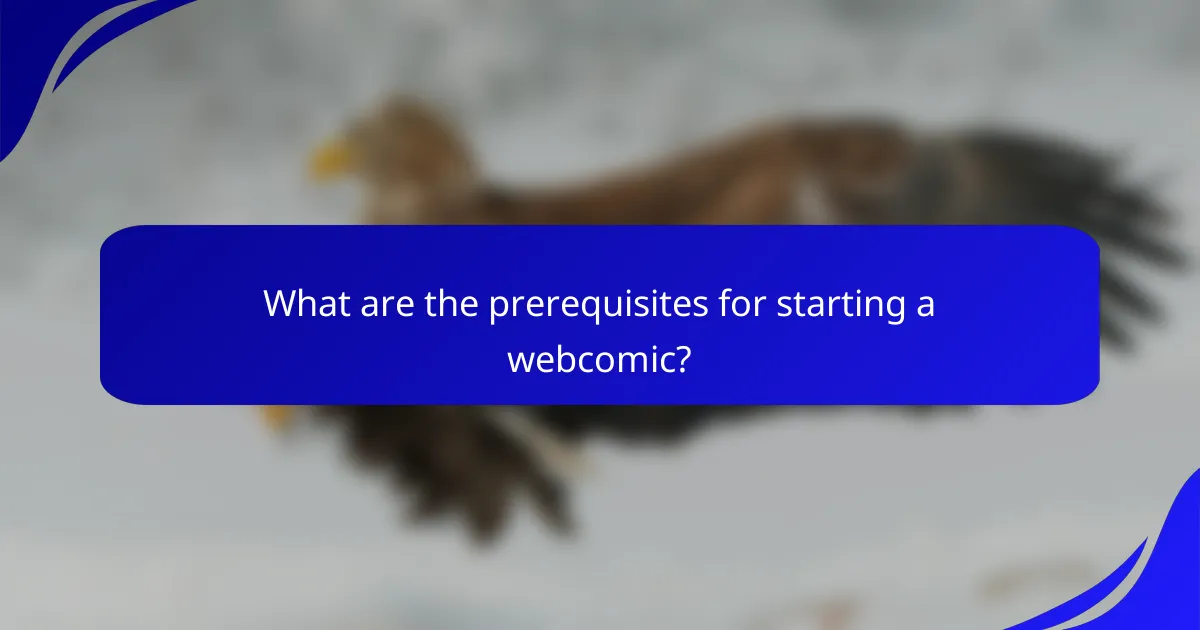Webcomic creators have the unique opportunity to enhance storytelling through visual elements and character development, creating a compelling narrative that resonates with readers. By implementing structured planning and utilizing tools for regular updates, they can maintain a consistent release schedule that keeps audiences engaged. Additionally, fostering interaction through social media and live sessions helps build a vibrant community, ensuring that readers remain invested in the unfolding story.

How can webcomic creators enhance storytelling?
Webcomic creators can enhance storytelling by utilizing visual elements, developing characters deeply, and structuring plots effectively. These techniques engage readers and foster a strong connection with the narrative.
Visual narrative techniques
Visual narrative techniques involve using imagery, color, and layout to convey emotions and themes. For instance, contrasting colors can highlight conflict, while softer palettes may evoke nostalgia or calmness. Creators should consider how panel arrangement affects pacing; dynamic layouts can create tension, while traditional grids may provide clarity.
Additionally, incorporating visual metaphors can enrich the storytelling experience. For example, a character surrounded by dark clouds may symbolize inner turmoil, enhancing the reader’s understanding without explicit dialogue.
Character development strategies
Effective character development strategies include creating relatable backstories and distinct personalities. Readers connect with characters who have clear motivations and flaws, making them more engaging. For example, a hero with a fear of failure can resonate with audiences who have faced similar challenges.
Regularly showcasing character growth through interactions and decisions is crucial. This can be achieved by placing characters in diverse situations that test their values, allowing readers to witness their evolution over time.
Engaging plot structures
Engaging plot structures often incorporate elements like conflict, resolution, and cliffhangers. A well-crafted conflict keeps readers invested, while a satisfying resolution provides closure. Creators should consider using episodic arcs that build on each other, maintaining reader interest through regular updates.
Incorporating twists or unexpected developments can also enhance engagement. For instance, revealing a character’s hidden past at a critical moment can surprise readers and deepen the narrative. Balancing predictability with surprises is key to keeping the audience captivated.

What are effective ways to maintain regular updates?
To maintain regular updates for webcomics, creators should implement structured planning and utilize various tools that streamline the content creation process. This ensures a consistent release schedule while keeping the audience engaged.
Content scheduling tools
Content scheduling tools help webcomic creators plan and automate their updates. Platforms like Buffer or Hootsuite allow you to schedule posts across multiple social media channels, ensuring your audience is informed of new releases without manual effort each time.
Consider using a calendar tool like Google Calendar to mark deadlines and release dates. This visual representation can help you stay organized and avoid last-minute rushes.
Batch creation methods
Batch creation involves producing multiple episodes or pages of your webcomic in one sitting. This method can enhance efficiency, as you can focus on a single creative flow without interruptions. Aim to create several weeks’ worth of content at once, which can help you maintain a steady update schedule.
Set aside dedicated time each week for this process. For example, if you typically release a new page every week, try to create four pages in a single session to stay ahead of your schedule.
Audience engagement for feedback
Engaging with your audience can provide valuable feedback that informs your updates. Use platforms like Discord or social media to create polls or discussions about upcoming story arcs or character developments. This interaction not only keeps your audience invested but can also spark new ideas.
Encourage comments and suggestions on your webcomic’s platform. Regularly reviewing this feedback can help you adjust your content to better meet audience expectations, ensuring they remain excited for each update.

How can webcomic creators interact with their audience?
Webcomic creators can interact with their audience through various methods that foster engagement and feedback. Utilizing social media, interactive tools, and live sessions helps build a community and keeps readers invested in the story.
Social media engagement
Social media platforms like Twitter, Instagram, and Facebook are essential for webcomic creators to connect with their audience. Regularly posting updates, behind-the-scenes content, and engaging with comments can enhance visibility and strengthen relationships with readers.
Creators should consider using hashtags relevant to their genre or themes to reach a broader audience. Engaging with fan art or reposting reader comments can also create a sense of community and encourage more interaction.
Interactive polls and surveys
Interactive polls and surveys allow creators to gather direct feedback from their audience about storylines, character development, or future content. Tools like Google Forms or social media polls can be used to ask specific questions that guide creative decisions.
For example, a creator might ask readers to vote on a character’s next move or what setting they would like to see next. This not only involves the audience but also makes them feel valued in the storytelling process.
Live Q&A sessions
Live Q&A sessions provide an opportunity for creators to interact with their audience in real-time. Platforms like Twitch, YouTube Live, or Instagram Live can be used to host these sessions, where fans can ask questions and receive immediate responses.
These sessions can cover a range of topics, from the creative process to character backstories. Promoting these events in advance can help ensure a good turnout and create a lively atmosphere for discussion.

What platforms are best for publishing webcomics?
Several platforms cater specifically to webcomic creators, each offering unique features and audience engagement opportunities. Choosing the right platform depends on your storytelling style, desired audience interaction, and monetization goals.
Webtoon
Webtoon is a popular platform for webcomic creators, known for its vertical scrolling format that enhances mobile reading. It offers a large, engaged audience and features like in-app tipping and ad revenue sharing, making it a viable option for monetization.
Creators can publish their work for free, but to maximize visibility, consider participating in Webtoon’s contests or promotions. Regular updates are crucial, as consistent posting can help build a loyal readership.
Tapas
Tapas provides a platform for both webcomics and novels, allowing creators to reach diverse audiences. It supports various monetization options, including ad revenue, tipping, and premium content sales, which can be beneficial for creators looking to earn income.
Engagement is key on Tapas; creators should interact with readers through comments and social media to foster a community. Regular updates and quality artwork can significantly increase visibility and reader retention.
Patreon
Patreon allows webcomic creators to build a subscription-based model, where fans can support them directly in exchange for exclusive content. This platform is ideal for creators who have an established audience and want to offer premium perks like behind-the-scenes content or early access to new comics.
To succeed on Patreon, creators should clearly communicate the value of their tiers and consistently deliver on promises. Regular updates and engaging with patrons can help maintain and grow support over time.

What are the monetization strategies for webcomic creators?
Webcomic creators can utilize various monetization strategies to generate income, including display advertising, merchandising options, and crowdfunding campaigns. Each approach has its own advantages and challenges, allowing creators to choose the best fit for their audience and content.
Display advertising
Display advertising involves placing ads on webcomic pages, allowing creators to earn revenue based on impressions or clicks. Platforms like Google AdSense make it easy to integrate ads, but creators should consider the balance between ad visibility and user experience.
To maximize earnings, webcomic creators should focus on attracting a larger audience and optimizing ad placements. However, it’s crucial to avoid overwhelming readers with too many ads, which can lead to decreased engagement.
Merchandising options
Merchandising allows webcomic creators to sell physical products, such as prints, apparel, or collectibles, based on their comic characters or themes. This strategy not only generates income but also strengthens the connection with fans.
Creators should consider starting with a few key items that resonate with their audience, using platforms like Etsy or Shopify for sales. Offering limited edition products can create urgency and boost sales, but managing inventory and production costs is essential to ensure profitability.
Crowdfunding campaigns
Crowdfunding campaigns enable webcomic creators to raise funds directly from their audience, often through platforms like Patreon or Kickstarter. This approach allows fans to support creators in exchange for exclusive content or rewards, fostering a sense of community.
Successful crowdfunding requires clear communication of goals and consistent updates to backers. Creators should set realistic funding targets and offer appealing rewards, but they must also be prepared to deliver on promises to maintain trust and encourage future support.

What are the prerequisites for starting a webcomic?
To start a webcomic, creators need a clear concept, artistic skills, and a platform for publishing. Understanding the target audience and committing to a regular update schedule are also crucial for success.
Artistic skills
Having artistic skills is essential for creating visually appealing webcomics. This includes drawing, inking, and coloring, as well as understanding composition and character design. While some creators may choose to collaborate with artists, developing at least basic drawing abilities can enhance storytelling.
Writing and storytelling
Strong writing and storytelling skills are vital for engaging readers. A compelling plot, well-developed characters, and effective dialogue can make a webcomic memorable. Consider outlining the story arc and character development before starting to ensure a cohesive narrative.
Technical knowledge
Familiarity with digital tools and software is important for producing webcomics. Programs like Adobe Photoshop, Clip Studio Paint, or free alternatives such as Krita can help in creating high-quality art. Additionally, understanding web publishing platforms, such as Webtoon or Tapas, is necessary for sharing your work with an audience.
Regular updates
Establishing a consistent update schedule is crucial for retaining readers. Many successful webcomic creators publish new content weekly or bi-weekly. Setting realistic goals for production can help maintain this schedule without sacrificing quality.
Engaging with the audience
Interacting with your audience can foster a loyal community around your webcomic. Utilize social media platforms to share updates, gather feedback, and encourage discussions. Consider incorporating reader suggestions or hosting Q&A sessions to enhance engagement.
